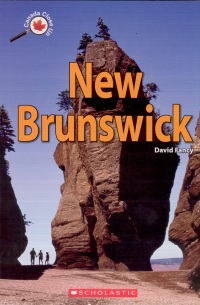| ________________
CM . . .
. Volume XVI Number 36. . . .May 21, 2010
New Brunswick, part of the “Canada Close Up” series, is a simple, straightforward account of the geography, history, and culture of the province of New Brunswick. Like many books of its kind, it is a useful tool for elementary social studies classrooms. It stands out among similar books in its careful explanation of New Brunswick as a bilingual province, one where many people switch back and forth easily between English and French, and because of its emphasis on Acadian culture and history. In David Fancy's book, New Brunswick isn't a drive-through province, but a worthy stop in its own right. With bright, vivid photographs and reproductions of paintings, David Fancy represents the beauty of the region. From the Hopewell Rocks in the Bay of Fundy and the Tantramar Marshes to the banks of the Miramichi, the book represents the most important aspects of New Brunswick's culture and geography. More difficult words are explained both in the text and in a glossary at the end of the book. Although the glossary is quite limited, the explanations it provides will help young readers to explore the text independently. While New Brunswick is quite well-researched and provides a detailed portrait of one of Canada's older and lesser-known provinces, there are a few omissions and strange turns of phrase in the descriptions of contemporary culture. For example, while the book describes the historic First Nations communities of New Brunswick at length and mentions that Metepenagiag is the oldest continuously inhabited village in the province, it focuses almost entirely on the past and makes no reference to the lifestyle and cultural celebrations of these communities today. In the chapter on bilingualism, readers are told, "Friends gather in doughnut shops." This may be true in some social circles, but it is by no means universal, nor is it specific to New Brunswick. Finally, in a section entitled "Camp time," the reader is informed that "Although New Brunswickers watch television, listen to and play music, and go to the movies like everyone else, their connection to the land is still important." Was New Brunswick's inclusion in twenty-first century culture ever in doubt? In attempting to breathe life into a dry nonfiction tome, Fancy manages to trivialize the lifestyles of the people whose culture he is celebrating. In spite of these lapses, New Brunswick is a lively introduction to the province. David Fancy's thorough research makes the book a great classroom resource and a useful jumping-off point for a social studies project. With accessible and engaging writing, and bright, vivid illustrations, this book will appeal to anyone with interest in Canada's Maritime provinces, and New Brunswick in particular. Highly Recommended. Meredith Snyder is an English teacher in Fredericton, NB.
To comment
on this title or this review, send mail to cm@umanitoba.ca.
Copyright © the Manitoba Library Association. Reproduction for personal
use is permitted only if this copyright notice is maintained. Any
other reproduction is prohibited without permission.
NEXT REVIEW |
TABLE OF CONTENTS FOR THIS ISSUE
- May 21, 2010.
AUTHORS |
TITLES |
MEDIA REVIEWS |
PROFILES |
BACK ISSUES |
SEARCH |
CMARCHIVE |
HOME |
